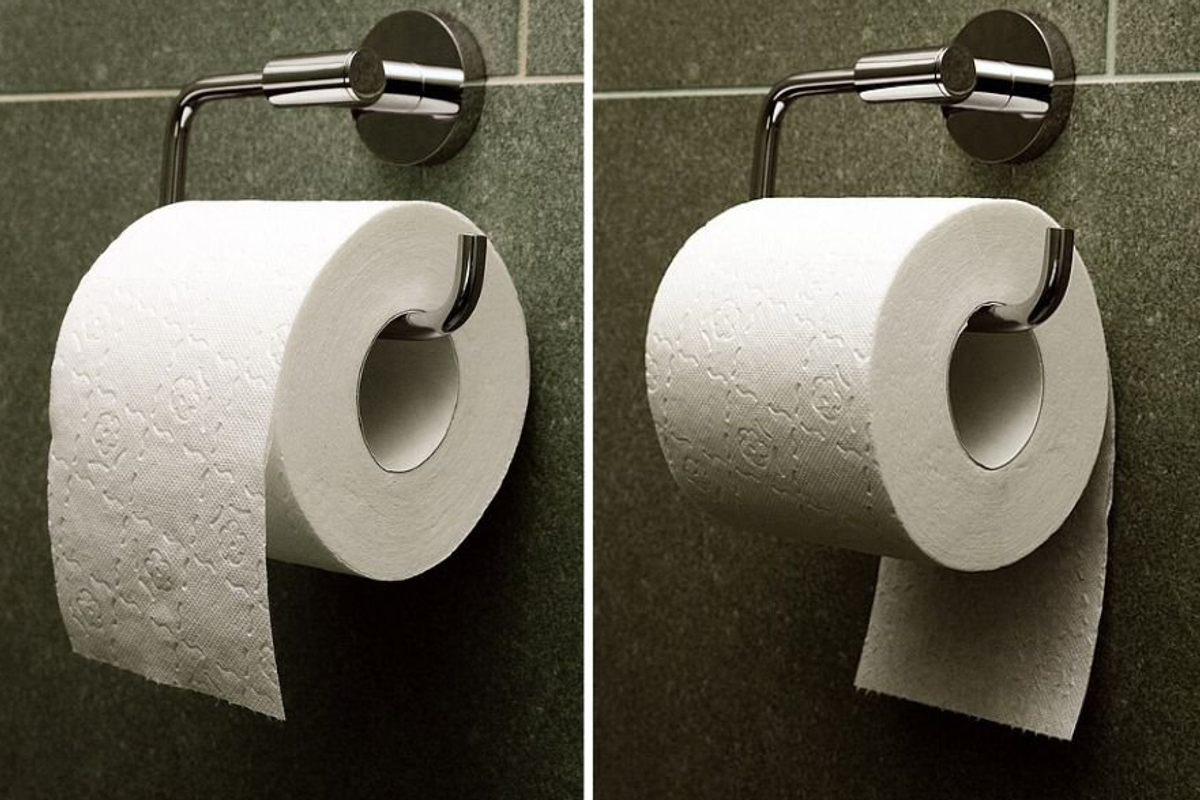Under or over? There actually is a 'right' way to hang a toilet paper roll.
The debate is settled, once and for all.

Should you hang the toilet paper roll over or under?
Humans have debated things large and small over the millennia, from democracy to breastfeeding in public to how often people ought to wash their sheets. But perhaps the most silly-yet-surprisingly heated household debate is the one in which we argue over which way to hang the toilet paper roll.
The "over or under" question has plagued marriages and casual acquaintances alike for over 100 years, with both sides convinced they have the soundest reasoning for putting their toilet paper loose end out or loose end under. Some people feel so strongly about right vs. wrong TP hanging that they will even flip the roll over when they go to the bathroom in the homes of strangers.
Contrary to popular belief, it's not merely an inconsequential preference. According to health experts and the man who invented the toilet paper roll, there is actually a "correct" way to hang toilet paper.
What is the correct way to hang a roll of toilet paper?
First, let's be clear about what we're even talking about here with a visual. In the image below, left is "over" and right is "under."

So which one is the right way? According to health experts, "over" is the way to go.
"One key to maintaining a hygienic washroom is minimising contact between people and surfaces," Dr. Christian Moro, associate professor of health sciences and medicine at Bond University on Australia's Gold Coast, told Australian Broadcasting Corporation. "Depending on the type of roll holder, [hanging the toilet paper "over"] often lowers the chance that a user will touch the wall behind when fishing for paper, leaving germs behind on that surface which can be spread to the next user."
Picture it: Grabbing the end of the toilet paper when it's hung "over" means you only touch the part of the toilet paper you're going to use. When it's "under," you sometimes have to fish for it or scrape your fingers on the wall in order to grab the loose end. In addition to whatever might be on people's hands already, think about all the people who wipe twice, potentially transferring fresh fecal matter or other bacteria to the wall on the second pass, which then get picked up by other people who inadvertently touch that wall when trying to grab their TP.
Theoretically, we all should have become better hand washers during the pandemic, scrubbing with soap for the full 20 seconds it takes to remove bacteria. But I wouldn't be willing to bet on it.

And touching any surface in a bathroom is pretty nasty, according to a study from the University of Colorado. As Inc. reported: "Using a high-tech genetic sequencing tool, researchers identified 19 groups of bacteria on the doors, floors, faucet handles, soap dispensers, and toilets of 12 public restrooms in Colorado — six men’s restrooms and six women’s restrooms. Many of the bacteria strains identified could be transmitted by touching contaminated surfaces."
Bacteria means things like e.coli, which is a common source of food poisoning and one of the most common bacteria found on bathroom surfaces in the study. If you've ever had a bout of food poisoning, I'm sure you'll agree that a toilet paper roll hanging preference isn't worth risking it.
But sanitary health concerns aren't the only argument for the "over" camp. After all, the original patent for the toilet paper roll, issued in 1891, clearly shows the TP in the "over" position. Thank you for the clarity right from the get go, Mr. Wheeler.

In Wheeler's patent, the perforated toilet paper hangs on a roll in the "over" position. In the words of the patent, the sheets of TP are “partially separated, having their points of attachment arranged in a novel manner, whereby each sheet will easily separate from the series as it is drawn from the roll, there being no litter occasioned, and any waste of paper is thereby prevented.”
Now, before the "under" folks come running with their pitchforks, there are some understandable exceptions to the "over" rule. Namely: cats and kids.
If you have a furry friend or a tiny toddler who likes to unroll the toilet paper roll, "over" makes it super fun for them, while "under" stops them in their tracks. For many people, cats and kids are the primary motivator of their TP hanging habits.
That doesn't change the fact that "over" is actually the "correct" way to hang toilet paper according to health science and the inventor's intention, of course, but "under" is certainly preferable to having a pile of TP on the floor.
Now go forth, do that with information as you will, and try to make peace with your over vs. under rivals.
This article originally appeared last year.
- Fed up parents explain why they 'never want to bring the kids over ... ›
- Engineer writes bulletproof rant on why 'over' is the optimal toilet paper position ›
- Over or under? Surprisingly, there actually is a 'correct' way to hang a toilet paper roll. ›
- Woman screams at a mom for bringing 2-year-old 'man' into the restroom. She had the best response. - Upworthy ›



 Tony Trapani received the most important letter of his life, but he didn't see it for 50 years Photo by
Tony Trapani received the most important letter of his life, but he didn't see it for 50 years Photo by  Tony and Samuel didn't waste time thinking about what might have been if he'd seen the letter earlier. Photo by
Tony and Samuel didn't waste time thinking about what might have been if he'd seen the letter earlier. Photo by 
 Public Media Actors On Actors GIF by PBS SoCal
Public Media Actors On Actors GIF by PBS SoCal 

